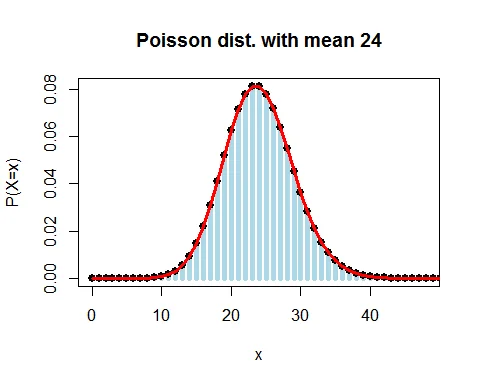Normal approximation to Poisson distribution
In this tutorial we will discuss some numerical examples on Poisson distribution where normal approximation is applicable. For large value of the $\lambda$ (mean of Poisson variate), the Poisson distribution can be well approximated by a normal distribution with the same mean and variance.
Let $X$ be a Poisson distributed random variable with mean $\lambda$.
The mean of $X$ is $\mu=E(X) = \lambda$ and variance of $X$ is $\sigma^2=V(X)=\lambda$.
The general rule of thumb to use normal approximation to Poisson distribution is that $\lambda$ is sufficiently large (i.e., $\lambda \geq 5$).
For sufficiently large $\lambda$, $X\sim N(\mu, \sigma^2)$. That is $Z=\frac{X-\mu}{\sigma}=\frac{X-\lambda}{\sqrt{\lambda}} \sim N(0,1)$.

Formula for continuity corrections
Poisson distribution is a discrete distribution, whereas normal distribution is a continuous distribution. When we are using the normal approximation to Poisson distribution we need to make correction while calculating various probabilities.
- $P(X=A)=P(A-0.5<X<A+0.5)$
- $P(X<A)=P(X<A-0.5)$
- $P(X\leq A)=P(X<A+0.5)$
- $P(A< X\leq B)=P(A-0.5<X<B+0.5)$
- $P(A\leq X< B)=P(A-0.5<X<B-0.5)$
- $P(A\leq X\leq B)=P(A-0.5<X<B+0.5)$
Example 1
The mean number of kidney transplants performed per day in the United States in a recent year was about 45. Find the probability that on a given day,
a. exactly 50 kidney transplants will be performed,
b. at least 65 kidney transplants will be performed, and
c. no more than 40 kidney transplants will be performed.
Solution
Let $X$ denote the number of kidney transplants per day. The mean number of kidney transplants performed per day in the United States in a recent year was about 45. $\lambda = 45$. $X$ follows Poisson distribution, i.e., $X\sim P(45)$.
Since $\lambda= 45$ is large enough, we use normal approximation to Poisson distribution. That is $Z=\dfrac{X-\lambda}{\sqrt{\lambda}}\to N(0,1)$ for large $\lambda$. (We use continuity correction)
a. The probability that on a given day, exactly 50 kidney transplants will be performed is
$$ \begin{aligned} P(X=50) &= P(49.5< X< 50.5)\\ & \quad\quad (\text{Using continuity correction})\\ &= P\bigg(\frac{49.5-45}{\sqrt{45}}<\frac{X-\lambda}{\sqrt{\lambda}}<\frac{50.5-45}{\sqrt{45}}\bigg)\\ &= P(0.67< Z<0.82)\\ & = P(Z<0.82) - P(Z< 0.67)\\ &= 0.7939-0.7486\\ & \quad\quad (\text{Using normal table})\\ &= 0.0453 \end{aligned} $$
b. The probability that on a given day, at least 65 kidney transplants will be performed is
$$ \begin{aligned} P(X\geq 65) &= 1-P(X\leq 64)\\ &= 1-P(X\leq 64.5)\\ & \quad\quad (\text{Using continuity correction})\\ &= 1-P\bigg(\frac{X-\lambda}{\sqrt{\lambda}}<\frac{64.5-45}{\sqrt{45}}\bigg)\\ &= 1-P(Z\leq 3.06)\\ &= 1-0.9989\\ & \quad\quad (\text{Using normal table})\\ &= 0.0011 \end{aligned} $$
c. The probability that on a given day, no more than 40 kidney transplants will be performed is
$$ \begin{aligned} P(X< 40) &= P(X< 39.5)\\ & \quad\quad (\text{Using continuity correction})\\ &= P\bigg(\frac{X-\lambda}{\sqrt{\lambda}}<\frac{39.5-45}{\sqrt{45}}\bigg)\\ &= P(Z<-0.82)\\ & = P(Z<-0.82) \\ &= 0.2061\\ & \quad\quad (\text{Using normal table}) \end{aligned} $$
Example 2
A radioactive element disintegrates such that it follows a Poisson distribution. If the mean number of particles ($\alpha$) emitted is recorded in a 1 second interval as 69, evaluate the probability of:
a. Less than 60 particles are emitted in 1 second.
b. Between 65 and 75 particles inclusive are emitted in 1 second.
Solution
Let $X$ denote the number of particles emitted in a 1 second interval. The mean number of $\alpha$-particles emitted per second $69$. Thus $\lambda = 69$ and given that the random variable $X$ follows Poisson distribution, i.e., $X\sim P(69)$.
Since $\lambda= 69$ is large enough, we use normal approximation to Poisson distribution. That is $Z=\dfrac{X-\lambda}{\sqrt{\lambda}}\to N(0,1)$ for large $\lambda$. (We use continuity correction)
a. The probability that less than 60 particles are emitted in 1 second is
$$ \begin{aligned} P(X< 60) &= P(X< 59.5)\\ & \quad\quad (\text{Using continuity correction})\\ &= P\bigg(\frac{X-\lambda}{\sqrt{\lambda}}<\frac{59.5-69}{\sqrt{69}}\bigg)\\ &= P(Z<-1.14)\\ & = P(Z<-1.14) \\ &= 0.1271\\ & \quad\quad (\text{Using normal table}) \end{aligned} $$
b. The probability that between $65$ and $75$ particles (inclusive) are emitted in 1 second is
$$ \begin{aligned} P(65\leq X\leq 75) &= P(64.5< X< 75.5)\\ & \quad\quad (\text{Using continuity correction})\\ &= P\bigg(\frac{64.5-69}{\sqrt{69}}<\frac{X-\lambda}{\sqrt{\lambda}}<\frac{75.5-69}{\sqrt{69}}\bigg)\\ &= P(-0.54<Z<0.78)\\ &= P(Z<0.78)- P(Z< -0.54) \\ &= 0.7823-0.2946\\ & \quad\quad (\text{Using normal table})\\ &= 0.4877 \end{aligned} $$